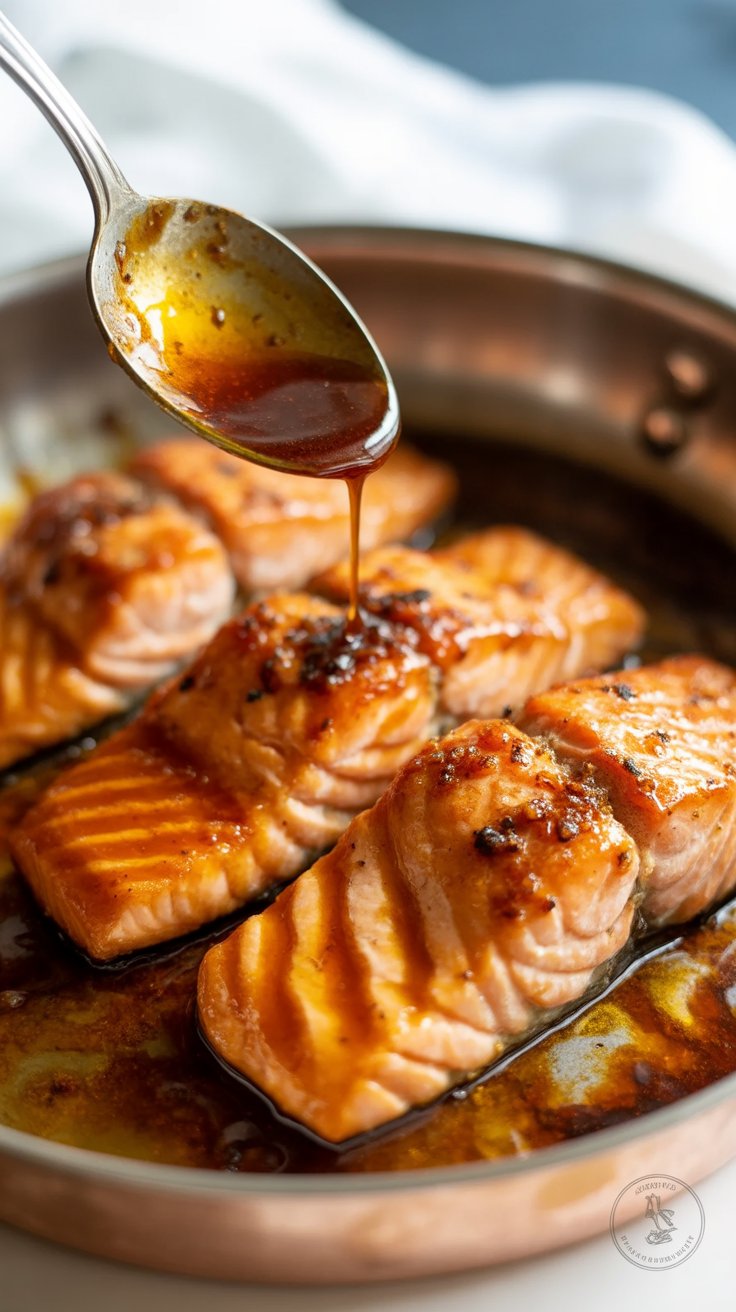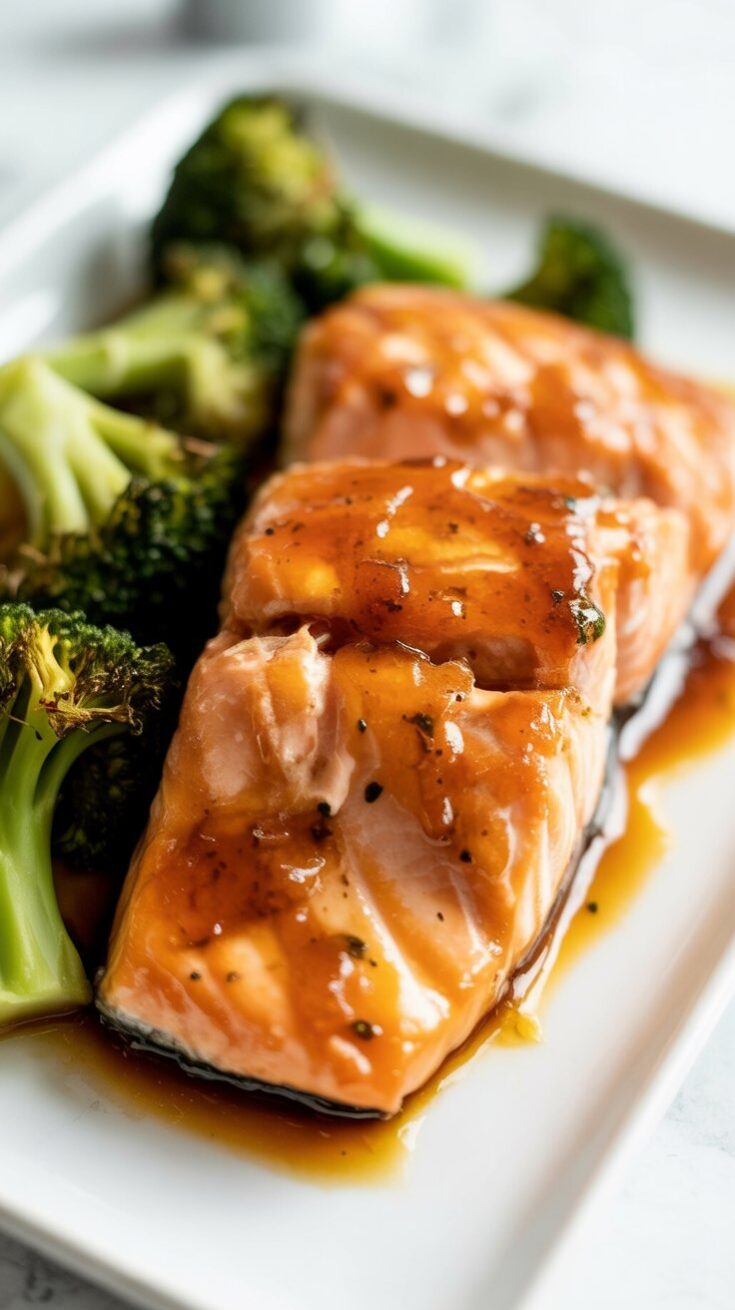This honey garlic sablefish has that kind of flavor that makes a simple weeknight meal feel like something you’d order at a cozy little restaurant. It’s buttery, flaky, and coated with a glossy glaze that clings to every bite. What I love most is how quickly it comes together — even on days when the freezer is my best friend.

What Makes This Dish Special
Sablefish, often called black cod, is one of those ingredients that doesn’t need much to shine. It’s naturally rich and silky, so even the simplest sauce feels indulgent. When I first cooked it at home, I was surprised by how forgiving it is. Unlike some leaner fish, it doesn’t dry out easily, which makes it a great choice if you’re still finding your way around seafood cooking.
The honey garlic glaze gives it just the right balance of sweet, salty, and garlicky. The edges caramelize beautifully in the pan, and the fish flakes apart like soft butter. I often pair it with something crisp and green — usually broccoli — so the glaze has something fresh to cling to.
What I Use in My Kitchen
-
Sablefish fillets (fresh or frozen)
-
Neutral oil like grapeseed for searing
-
Honey for that golden sweetness
-
Garlic and ginger for punchy depth
-
Soy sauce or tamari to bring in the savory note
-
Toasted sesame oil for aroma
-
Crushed red pepper flakes for a subtle kick
-
Fresh broccoli for a simple side
The ingredients are simple, but once they hit the pan, the kitchen smells incredible.

How I Cook It
I’ve cooked this a few different ways, but pan-searing with the glaze is my go-to method because it gives me that golden crust I love.
-
Prep the fish: If it’s frozen, I rinse and pat it very dry. This helps the sear.
-
Make the glaze: A quick whisk of honey, garlic, ginger, soy sauce, sesame oil, and red pepper flakes. I usually do this in a small bowl or shake it up in a jar.
-
Cook the fish: I heat oil in a skillet over medium-high and lay the fish down gently. The trick is to leave it alone for at least a few minutes so it forms that crust.
-
Baste with the glaze: Once the first side is golden, I flip it and spoon the sauce over the top. It thickens slightly and coats the fish beautifully.
-
Finish and serve: When the fish flakes easily with a fork, it’s ready.
I usually cook the broccoli in the same pan after the fish is done so it picks up some of that glaze.
Personal Tips That Make a Difference
-
Don’t crowd the pan: I made this mistake early on and ended up steaming the fish instead of searing it. A little space goes a long way.
-
Let the fish cook undisturbed: This is key to getting that golden crust without tearing the fillet.
-
Adjust for thickness: Sablefish fillets can vary in size. Thicker ones need a few extra minutes, thinner ones a bit less.
-
Add a splash of water or broth: If the glaze thickens too fast, a quick splash brings it back to a silky texture.
Make-Ahead Pointers
This recipe is best served fresh, but you can make the sauce ahead of time and keep it in the fridge for up to a week. If you’re using frozen fish, you can cook it straight from the freezer — just add a few minutes to the cooking time. I love that it doesn’t require any last-minute thawing.
How I Serve It
-
Over a warm bowl of rice with the broccoli tucked alongside
-
With roasted vegetables and a drizzle of extra glaze on top
-
Flaked over noodles with a few sesame seeds scattered on top
-
With a crisp salad on the side for something light
When I make this for a special dinner, I like to plate it with a little extra sauce and a squeeze of lime to brighten everything up.
Storage Tips
-
Fridge: Keep leftovers in an airtight container for up to two days.
-
Reheat gently: I prefer warming it slowly on the stove with a spoonful of water or broth to keep the fish moist.
-
Avoid over-reheating: Sablefish is delicate and can toughen if cooked again for too long.

FAQs
Can I use a different fish?
Yes. Salmon, cod, halibut, or pollock work nicely. Just adjust the cooking time depending on the thickness of the fillet.
Can I bake the fish instead of pan-searing it?
Yes. Bake at 400°F and brush with the glaze halfway through cooking. Finish with a quick broil for a nice caramelized top.
What can I use instead of soy sauce?
Tamari works well for a gluten-free option. Coconut aminos adds a slightly sweeter flavor.
Do I need to thaw frozen sablefish first?
No. It can be cooked from frozen — just allow a few extra minutes in the pan.
Honey Garlic Sablefish (Black Cod)

Sablefish, also known as black cod, has a melt-in-your-mouth texture that pairs beautifully with a sweet and savory honey garlic glaze.
Ingredients
- 1 pound Alaska sablefish (black cod), cut into 4 fillets
- 12 ounces fresh broccoli florets
- 3 tablespoons grapeseed oil (or another neutral oil), divided
- 3 tablespoons coconut aminos (or low-sodium soy sauce or tamari)
- 5 tablespoons honey
- 1 teaspoon toasted sesame oil
- 4 cloves garlic, grated
- 1 inch fresh ginger, grated
- ½ teaspoon crushed red pepper flakes
- Coarse salt and black pepper, to taste
- Cooked rice, for serving (optional)
Instructions
- Preheat the oven to 400°F and line a baking sheet with parchment or lightly spray it with oil.
- In a bowl or small jar, whisk together 2 tablespoons grapeseed oil, coconut aminos, honey, sesame oil, garlic, ginger, and red pepper flakes until smooth.
- Toss the broccoli florets with about ⅓ cup of the honey garlic sauce until evenly coated. Arrange them in a single layer on the prepared baking sheet and roast for about 15 minutes, until caramelized and tender.
- Pat the sablefish fillets completely dry and season both sides with salt and black pepper. Heat the remaining tablespoon of grapeseed oil in a large skillet over medium-high heat.
- Place the fish in the hot skillet, skin side up. Sear until golden brown, about 4 minutes, then flip carefully. Pour the remaining sauce into the skillet and let it bubble gently. Cook for about 5 minutes, basting the fillets with the sauce as it reduces to a glossy glaze. The fish should flake easily and reach an internal temperature of 145°F.
- Serve the sablefish warm with the roasted broccoli and a scoop of rice if you like, drizzled with extra sauce from the pan.
Notes
- For best results, thaw the fish overnight in the refrigerator or under cool water before cooking.
- Drying the fish well before searing helps create a beautiful crust and reduces splatter.
- Cooking time may vary depending on the thickness of your fillets, so keep an eye on the fish for perfect doneness.
Nutrition Information
Yield
4Serving Size
1Amount Per Serving Calories 561Total Fat 34gSaturated Fat 6gUnsaturated Fat 25gCholesterol 71mgSodium 465mgCarbohydrates 43gFiber 3gSugar 25gProtein 23g
Easy Shrimp Recipes.com, occasionally offers nutritional information for recipes contained on this site. This information is provided as a courtesy and is an estimate only. This information comes from online calculators. Although allchickenrecipes.com attempts to provide accurate nutritional information, these figures are only estimates.
Final Thought
Honey garlic sablefish has become one of those dishes I turn to when I want something special without spending all evening in the kitchen. It’s rich, flaky, and full of flavor, but still feels light enough for any day of the week. Once you make it, you’ll probably keep a couple of fillets tucked away in your freezer — just like I do.

